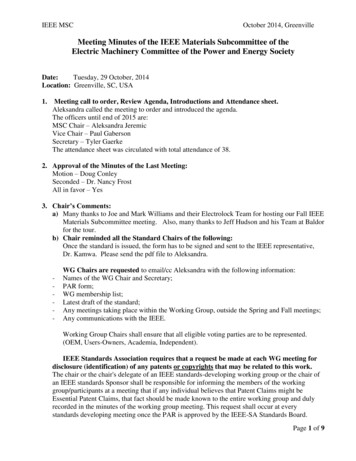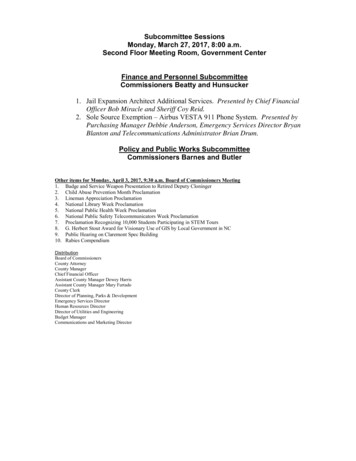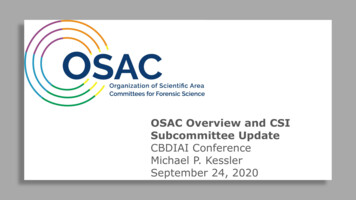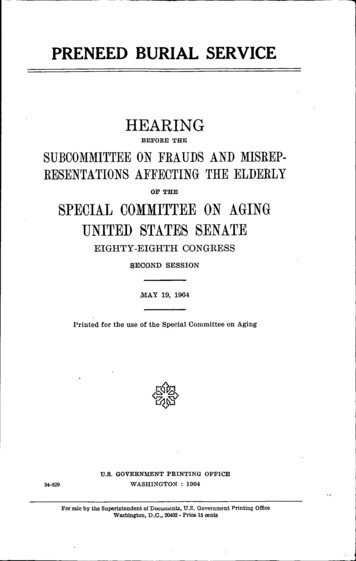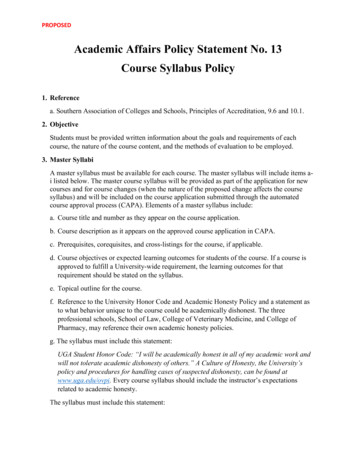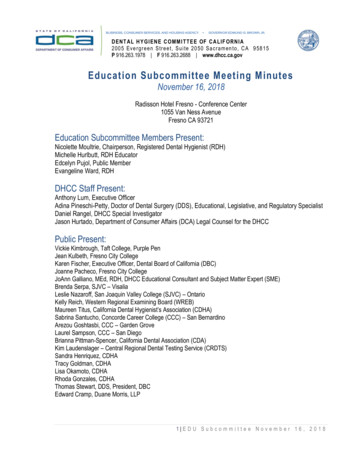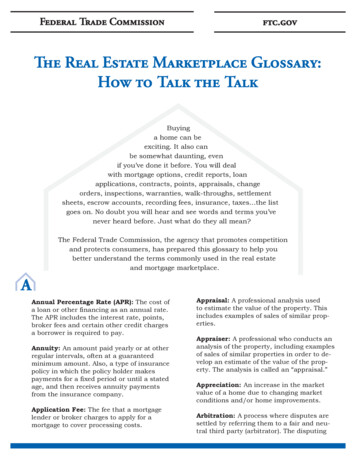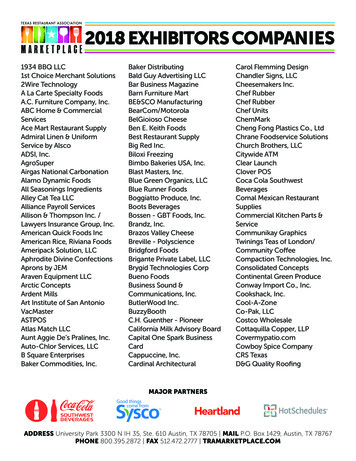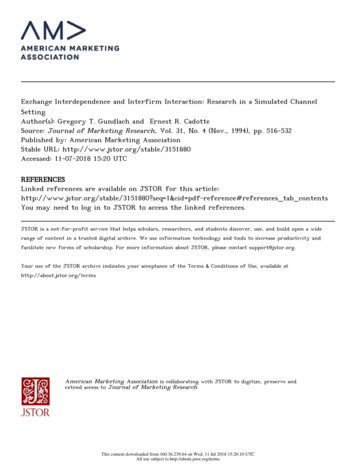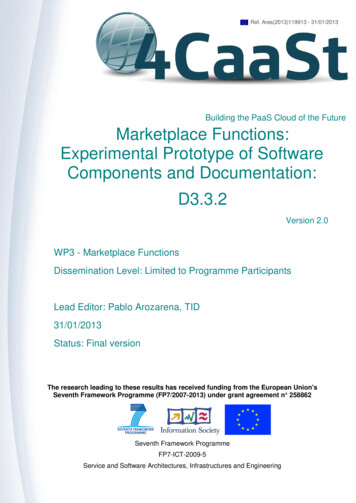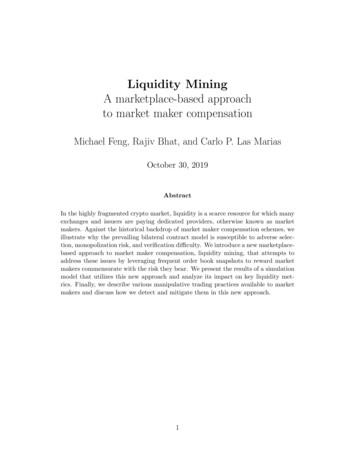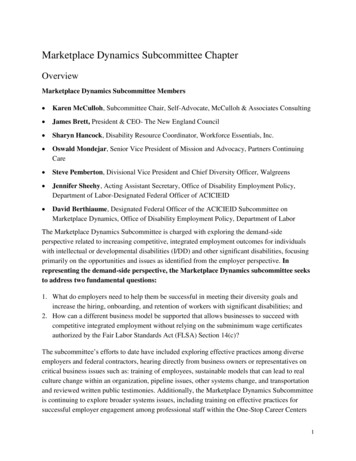
Transcription
Marketplace Dynamics Subcommittee ChapterOverviewMarketplace Dynamics Subcommittee Members Karen McCulloh, Subcommittee Chair, Self-Advocate, McCulloh & Associates Consulting James Brett, President & CEO- The New England Council Sharyn Hancock, Disability Resource Coordinator, Workforce Essentials, Inc. Oswald Mondejar, Senior Vice President of Mission and Advocacy, Partners ContinuingCare Steve Pemberton, Divisional Vice President and Chief Diversity Officer, Walgreens Jennifer Sheehy, Acting Assistant Secretary, Office of Disability Employment Policy,Department of Labor-Designated Federal Officer of ACICIEID David Berthiaume, Designated Federal Officer of the ACICIEID Subcommittee onMarketplace Dynamics, Office of Disability Employment Policy, Department of LaborThe Marketplace Dynamics Subcommittee is charged with exploring the demand-sideperspective related to increasing competitive, integrated employment outcomes for individualswith intellectual or developmental disabilities (I/DD) and other significant disabilities, focusingprimarily on the opportunities and issues as identified from the employer perspective. Inrepresenting the demand-side perspective, the Marketplace Dynamics subcommittee seeksto address two fundamental questions:1. What do employers need to help them be successful in meeting their diversity goals andincrease the hiring, onboarding, and retention of workers with significant disabilities; and2. How can a different business model be supported that allows businesses to succeed withcompetitive integrated employment without relying on the subminimum wage certificatesauthorized by the Fair Labor Standards Act (FLSA) Section 14(c)?The subcommittee’s efforts to date have included exploring effective practices among diverseemployers and federal contractors, hearing directly from business owners or representatives oncritical business issues such as: training of employees, sustainable models that can lead to realculture change within an organization, pipeline issues, other systems change, and transportationand reviewed written public testimonies. Additionally, the Marketplace Dynamics Subcommitteeis continuing to explore broader systems issues, including training on effective practices forsuccessful employer engagement among professional staff within the One-Stop Career Centers1
and Workforce Development Boards (WDBs). The subcommittee also received presentationsand participated in an informational dialogue with representatives from the following entities:AbilityOne, the US Business Leadership Network, Ad Astra Business Solutions, the NationalAssociation of Workforce Boards, SourceAmerica, The National Council on Disability,Disability Rights Education and Defense Fund, and Association of Programs for RuralIndependent Living. In addition, subcommittee members have acted as subject matter experts(SMEs), bringing their perspectives, professional experiences and knowledge to the forefront tofurther inform the exploratory work of the subcommittee specifically and the full AdvisoryCommittee generally.For this Interim Report, the subcommittee addresses the following primary topic areas:1.2.3.4.5.6.Changing the Business NarrativeCreating a Sustainable Culture of InclusionBuilding Business Partnerships While Driving Systems ChangeAddressing Training and Pipeline IssuesTransportation Impact on Business Recruitment of TalentPreliminary RecommendationsInitial findings and conclusions are detailed for all topic areas, followed by preliminaryrecommendations as appropriate. Future topics to be explored and included in the final reportinclude: OFCCP 503 Rules; state use programs; high growth industries (HGIs) such astechnology, health care, and retail; more effective employer engagement with WDBs andVocational Rehabilitation (VR); self-employment for people with I/DD and other significantdisabilities; and IRS Tax Incentives for businesses in order to encourage the hiring of peoplewith disabilities and remove architectural barrier. Additionally, ongoing research and furtherexploration continues for the topics covered in this Interim Report.Changing the Business NarrativeCurrently, the predominant business narrative for hiring individuals with disabilities in Americais that it is simply “the right thing to do,” thus appearing to be a patriarchal appeal, rather than anidentification of the opportunities and benefits associated with developing an inclusiveworkforce. Further, such a pervasive message can perpetuate negative perceptions and lowexpectations for employees with I/DD and other significant disabilities. The Subcommitteebelieves that pushing business to employ workers with disabilities out of a sense of duty orcorporate social responsibility may unintentionally undermine the identities and worth ofjobseekers with disabilities, and eclipse the reality that individuals with I/DD or other significantdisabilities are essential, capable, and efficient members of the community workforce. “Doing2
the right thing” runs contrary to why businesses hire employees in the first place – to fill aneed and to support the company’s business model to enhance their bottom line.The Marketplace Dynamics Subcommittee’s findings, conclusions, and recommendations focuson the critical need to change this narrative and to help educate employers that hiringpeople with disabilities can be good for any business’s bottom line. Businesses withworkforces that include employees with I/DD or other significant disabilities consistently reportthat these employees’ performance equals or exceeds that of their coworkers without disabilities(Kessler, 2010). As such, hiring persons with disabilities must be recognized as a cost-effectiveway to build an inclusive workforce that is representative of the business’s customer base, andindividuals with significant disabilities must be perceived and portrayed as an asset to thecompany, not a risk.The Marketplace Dynamics Subcommittee recommends that the business narrative move fromone of corrective action to one of competitive advantage. Business leaders must understandthat hiring individuals with I/DD or other significant disabilities will allow them to increaserevenue or better meet other targets specific to their business models. Business decision-makingis based upon data. At the same time, research has shown that exposure to people withdisabilities may be more effective at reducing employer discrimination than demonstratingsubstantial cost-benefits; thus, efforts to directly engage employers in an ongoing dialogue withprospective workers with disabilities also plays an important role in changing the businessnarrative (Office of Disability Employment Policy, 2015; Social Dynamics, LLC, 2014). Asemployers recognize that developing a more inclusive workforce results in competitivedifferentiation within their industry, they adopt this as a continuous, standard component of theirhuman resource process.To effectively change the current narrative, employers need evidence and examples that personswith significant disabilities both want to work and are qualified and dedicated employees.Success stories from businesses that have strategically developed a more inclusiveworkforce model can be promoted to illustrate the benefits from a business perspective.While the specific benefits may vary across businesses, results from these strategic initiativespoint to a wide array of positive outcomes, from increased productivity to reduced turn-over andlower absenteeism rates (Matos & Galinsky, 2014; Matos, 2014; Kessler, 2010). In 2007, Walgreens launched an initiative to hire more individuals with disabilities in thefirst of a new generation of distribution centers. Emphasizing their theme of “Training versusAbilities” as a high priority, training facilities were embedded inside the distribution centersin South Carolina and Connecticut. Inside each distribution center, workstation computerscreens were changed from text-based information data entry to touchscreens using icons,adjustable workstations were installed, and processes were simplified and centralized to3
better support a diverse workforce. The results thus far have been powerful: the newdistribution centers have increased efficiency by 20% overall. Investments to streamline thetechnology and processes paid off by improving the efficiency of all employees, not justthose with disabilities. Walgreens reports that in the distribution centers, employees withdisabilities perform as well or better than other employees as a whole (Pemberton, 2015). In2012, Walgreens expanded this initiative into their retail stores through the Retail Employeeswith Disabilities Initiative (REDI). REDI provides in-store training to help people withdisabilities develop the skills required for retail and customer service jobs and includespartnerships with local employment service agencies and state Vocational Rehabilitationagencies to provide the necessary funding and support. Externs trained in the 4-6 weekprogram are evaluated, and those scoring high enough are recommended for hire and invitedto apply for jobs. Of the 784 REDI externs who completed the training, 67% wererecommended for hire, and 165 were hired by Walgreens. Those not hired by Walgreensreceived valuable skills training that can serve as the foundation for other communityemployment, though Walgreens does not track these outcomes. AMC’s Furthering Opportunities, Cultivating Untapped Strengths (FOCUS) Programincorporates intentional outreach to recruit youth with significant disabilities for entry-levelpositions, with competitive pay and benefits. Changes to standard business practices insupport of the FOCUS program included changing the interview process from “sit down”interview to “traveling” interviews, where managers walk through the theaters with potentialemployees; revision of training materials to make them more visual; and including parents orjob coaches in performance feedback sessions where appropriate. In an effort to address theperformance variability across job coaches, AMC created guidance and standards detailingthe company’s expectations for all job coaches working with AMC employees. AMC reportsthat employees with significant disabilities consistently perform as well as or better than theirpeers without disabilities and consistently exceed their own job performance expectationsalong with the expectations of their family members. As a result the changes made throughthe FOCUS program, AMC has improved policy and practices system-wide and positivelyimpacted their corporate culture as a whole. Approximately 75% of the employees at Habitat International, Inc. (www.habitatinc.com), aChattanooga-based supplier of artificial-grass and carpet products, experience a disability.Habitat cites an impressive list of business data, including: zero back orders in 24 years, aproduct defect rate of less than 1%, very low turn-over and absenteeism, a reduced number ofsupervisors, and lower administrative costs. These successes highlight the myriad of ways inwhich supporting a more inclusive workforce contributes to a better bottom line. Savingsfrom developing a reliable workforce are profound and can be realized by assessing the costsof the vacancy including advertising, lost productivity, and training time for a new employee.4
Many of the better-known business success stories come from large businesses with full-scaleinitiatives to include more people with disabilities within their workforce. Yet the vast majorityof businesses in the U.S. are those employing fewer than 100 people, so small and medium-sizedbusinesses must be part of the dialogue on how to improve competitive, integrated employmentopportunities for workers with significant disabilities. Smaller businesses are less likely to havestrategic plans targeting the recruitment of people with disabilities, including individuals withI/DD and other significant disabilities (Matos, 2014; Kessler 2010). Positive impacts on thebusiness bottom line can occur at businesses of all sizes and in all locations; however,evidence and examples from a variety of businesses and industries – small, mid-size, andlarge – are needed to advance the narrative and keep it relevant for a greater number ofbusinesses throughout both rural and urban communities.Creating a Sustainable Culture of InclusionThere has never been a greater need for creating a sustainable culture of inclusion within bothpublic and private sector workplaces throughout the United States than there is today. For toolong, the presumption that people with I/DD and other significant disabilities will not be able tomeet the job requirements of competitive, integrated work environments has resulted in limitedaccess to innovative training opportunities and very few individuals achieving economic selfsufficiency. Data from the 2013 SSI Annual Statistical report shows that of the almost 5 millionindividuals with disabilities between the ages of 18 and 64, less than 300,000 (5.9%) wereworking (SSI Annual Statistical Report, 2013). Monthly earnings averaged less than 1400: noteven 17,000 per year. Employees with disabilities earn less on average, are more likely to workpart-time or in temporary positions, and are less likely to work in technical or managerialpositions than their peers without disabilities (Bureau of Labor Statistics, 2014; Shur et. al.,2009).From the Marketplace Dynamics Subcommittee’s point of view, there are many companies thatare proving that employees with significant disabilities are highly valued in their workforce,which dispels myths and stereotypes directed to this disability population. More needs to beaccomplished, however. Creating a sustainable culture of inclusion requires a dedicatedeffort, and companies, regardless of size, need a tactical, executable plan supported bymiddle management, executive leadership, and their Board of Directors in order to recruit,train, retain and promote individuals with I/D
The Marketplace Dynamics Subcommittee recommends that the business narrative move from one of corrective action to one of competitive advantage. Business leaders must understand that hiring individuals with I/DD or other significant disabilities will allow them to increase revenue or better meet other targets specific to their business models. Business decision-making
